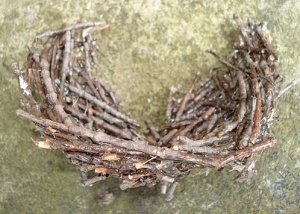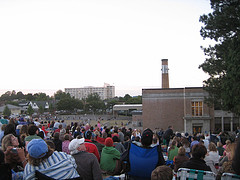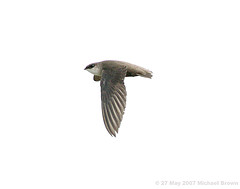Chimney Swifts in Connecticut
The Chimney Swift Project is a joint venture between the Uconn Ornithology Research Group and the Connecticut Department of Environmental Protection (CTDEP). Chimney Swifts are a common sight in the skies of the Northeast throughout the spring and summer months, but populations have declined steadily over the last several decades across their entire range. In 2006, the CTDEP issued Connecticut's Comprehensive Wildlife Strategy aimed at guiding the state's conservation efforts over the next several years. A main tenet of this document is to "Keep common species common", encouraging a proactive approach to managing wildlife species that may become threatened in the future. The Chimeny Swift certainly fits this description, and with this project we hope to accomplish the following:
- Develop and test the effectiveness of a newly designed artificial nesting structure
- Develop an effective monitoring program
- Understand the habitat associations of Chimney Swifts
Biology and Conservation Status
The Chimney Swift (Chateura pelagica) is a migratory bird that typically returns to Connecticut from South America during the final week of April, and breeds during the end of May and June. They are aerial insectivores that spend nearly all day in the air and roost at night on sheltered, vertical surfaces. Historically, the Chimney Swift roosted and nested in large hollow trees in the Northeast, but as European colonization removed most large trees and inserted chimneys, the swifts took advantage of this new structure. Chimney Swift nests are constructed from small twigs that are glued together onto a vertical surface using saliva, forming a semicircular cup nest (see photo at right). Suitable chimney nesting sites have declined over the past several decades as older chimneys are torn down, capped, and lined. Newly built chimneys are typically built with a liner and a cap in place, making it nearly impossible for swifts to get inside and establish a nest. Nest site limitation may be a factor in the observed population decline, which has spurred interest in creating artificial chimneys that could provide additional nesting opportunities.
Artificial Nesting Structures
One of the main goals of this project is to design and deploy chimney swift "towers". These towers are freestanding chimney-like structures designed to provide nesting and roosting habitat for swifts. Several organizations have published tower designs that have been demonstrated to successfully attract breeding swifts, but none of these designs have been empirically tested. Although these tower designs have been successful, they can be expensive, labor intensive, and require significant skill to constuct. We are currently in the process of testing a new tower design that is relatively inexpensive, easy to construct, moveable, and composed of materials that are easy to obtain. A design that incorporates each of these characteristics is much more likely to be constructed and deployed by state agencies, conservation organizations, and private landowners. Our Swift Towers have been installed in and around Storrs, and will be evaluated throughout the breeding season.
Monitoring
The CTDEP has been testing monitoring techniques for Chimney Swifts for the past several years. In cooperation with other state and federal agencies, universities, and non-profit organizations, the CT DEP is piloting a montoring technique that will quantify chimney swift occupancy and detection probability in chimney structures. In order to quantify differences in chimney swift presence and detection among habitat types, we have stratified our sampling program to target habitat types where Chimney Swifts are most detectable, leading to a potentially better understanding of population size and long-term population trends.
Public Education
This project offers several opportunities for public outreach and education. Swifts are typically active throughout the day and can be easily observed in locations where they nest in large flocks (see photo at right from Portland, OR); Chimney Swifts nesting in Connecticut would undoubtedly inspire similar interest. Video cameras have been installed in all of the tower prototypes, which may provide rare and intimate views of roosting, nesting, and fledging behavior. These video cameras could become permanent fixtures in classrooms throughout the state. Public involvement in monitoring activities would be useful - and in some cases essential - for developing a better understanding of large-scale patterns of Chimney Swift breeeding, abundance, and distribution.
Send questions or comments to Tanner [1]: tanner.steeves[AT]uconn.edu
Photo Credits:
(1) Michael Brown, 2007. http://www.flickr.com/photos/67383370@N00/518587619/
(2) Mon@rch: http://monarchbfly.com
(3) Irene: http://www.flickr.com/photos/7791990@N04/1431355860/



